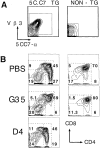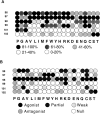A T cell receptor-specific blockade of positive selection
- PMID: 9874560
- PMCID: PMC1887687
- DOI: 10.1084/jem.189.1.13
A T cell receptor-specific blockade of positive selection
Abstract
To investigate the influence of endogenous peptides on the developmental processes that occur during thymocyte selection, we have used monoclonal antibodies that preferentially recognize the major histocompatibility complex (MHC) molecule I-Ek when it is bound to the moth cytochrome c peptide (88-103). One of these antibodies (G35) specifically blocks the positive selection of transgenic thymocytes expressing a T cell receptor that is reactive to this peptide- MHC complex. Furthermore, G35 does not block the differentiation of transgenic T cells bearing receptors for a different I-Ek-peptide complex. This antibody recognizes a subset of endogenous I-Ek-peptide complexes found on a significant fraction of thymic antigen-presenting cells, including cortical and medullary epithelial cells. The sensitivity of G35 to minor alterations in peptide sequence suggests that the thymic peptide-MHC complexes that mediate the positive selection of a particular class II MHC-restricted thymocyte are structurally related to the complexes that can activate it in the periphery.
Figures











Similar articles
-
Analysis of peptide binding patterns in different major histocompatibility complex/T cell receptor complexes using pigeon cytochrome c-specific T cell hybridomas. Evidence that a single peptide binds major histocompatibility complex in different conformations.J Exp Med. 1989 Nov 1;170(5):1609-25. doi: 10.1084/jem.170.5.1609. J Exp Med. 1989. PMID: 2553848 Free PMC article.
-
Inhibition of I-Ad-, but not Db-restricted peptide-induced thymic apoptosis by glucocorticoid receptor antagonist RU486 in T cell receptor transgenic mice.Eur J Immunol. 1996 Feb;26(2):428-34. doi: 10.1002/eji.1830260224. Eur J Immunol. 1996. PMID: 8617314
-
Weak positive selection of transgenic T cell receptor-bearing thymocytes: importance of major histocompatibility complex class II, T cell receptor and CD4 surface molecule densities.Eur J Immunol. 1992 Mar;22(3):703-9. doi: 10.1002/eji.1830220313. Eur J Immunol. 1992. PMID: 1547816
-
Low-affinity peptides and T-cell selection.Trends Immunol. 2009 Feb;30(2):53-60. doi: 10.1016/j.it.2008.11.004. Epub 2009 Feb 7. Trends Immunol. 2009. PMID: 19201651 Review.
-
Peptide presentation by class-I major histocompatibility complex molecules.Immunol Res. 1991;10(1):54-65. doi: 10.1007/BF02918167. Immunol Res. 1991. PMID: 1865131 Review.
Cited by
-
Functional development of the T cell receptor for antigen.Prog Mol Biol Transl Sci. 2010;92:65-100. doi: 10.1016/S1877-1173(10)92004-8. Prog Mol Biol Transl Sci. 2010. PMID: 20800817 Free PMC article.
-
Efficient generation of monoclonal antibodies against peptide in the context of MHCII using magnetic enrichment.Nat Commun. 2016 Jun 13;7:11804. doi: 10.1038/ncomms11804. Nat Commun. 2016. PMID: 27292946 Free PMC article.
-
Visualization of myelin basic protein (MBP) T cell epitopes in multiple sclerosis lesions using a monoclonal antibody specific for the human histocompatibility leukocyte antigen (HLA)-DR2-MBP 85-99 complex.J Exp Med. 2000 Apr 17;191(8):1395-412. doi: 10.1084/jem.191.8.1395. J Exp Med. 2000. PMID: 10770805 Free PMC article.
-
Antigen presentation: lysoyme, autoimmune diabetes, and Listeria--what do they have in common?Immunol Res. 2005;32(1-3):267-92. doi: 10.1385/IR:32:1-3:267. Immunol Res. 2005. PMID: 16106079 Review.
-
Diversity of T cell repertoire shaped by a single peptide ligand is critically affected by its amino acid residue at a T cell receptor contact.Proc Natl Acad Sci U S A. 2000 Dec 5;97(25):13760-5. doi: 10.1073/pnas.250470797. Proc Natl Acad Sci U S A. 2000. PMID: 11087837 Free PMC article.
References
-
- Sha WC, Nelson CA, Newberry RD, Kranz DM, Russell JH, Loh DY. Positive and negative selection of an antigen receptor on T cells in transgenic mice. Nature. 1988;336:73–76. - PubMed
-
- Kisielow P, Teh HS, Bluthmann H, von Boehmer H. Positive selection of antigen-specific T cells in thymus by restricting MHC molecules. Nature. 1988;335:730–723. - PubMed
-
- Berg LJ, Pullen AM, Fazekas de St B, Groth, Mathis D, Benoist C, Davis MM. Antigen/MHC-specific T cells are preferentially exported from the thymus in the presence of their MHC ligand. Cell. 1989;58:1035–1046. - PubMed
-
- Bevan MJ. In thymic selection, peptide diversity gives and takes away. Immunity. 1997;7:175–178. - PubMed
Publication types
MeSH terms
Substances
Grants and funding
LinkOut - more resources
Full Text Sources
Other Literature Sources
Research Materials

